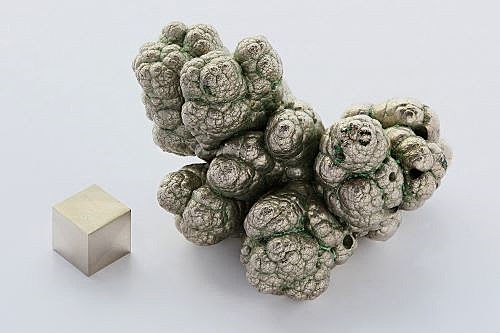Nickel (Ni): Metallurgy Facts & Folklore
- Sylvia Rose

- Nov 29, 2024
- 6 min read
Updated: Dec 15, 2024
Nickel (Ni), a silvery-white metal with a lustrous sheen, is a transition element essential to industry and commerce, and known in history for centuries. Its unique combination of strength and versatility makes nickel a desirable metal but obtaining this prize is not so easy.
If the green salts aren't visible in above pic, tap image to go to bigger pic.
Properties of Nickel
Nickel, with atomic number 28, is characterized by its robust physical and chemical properties. It has a melting point of 1455 °C (2,651 °F) and a boiling point of 2912 °C (5,274 °F).
A lustrous, silvery white metal, nickel exhibits excellent corrosion resistance, especially when alloyed, and is ferromagnetic, or strongly susceptible to magnetism. Nickel is also notable for its durability and ability to withstand high temperatures.

Nickel makes up about 0.008% of the Earth's crust. Oxygen is the most common element of the crust at 46%, followed by silicon at 28.2%. Commercially valuable metals such as copper, nickel, gold, silver, platinum, palladium and zinc are all trace elements in the crust.
Nickel is highly ductile, meaning it can be drawn into wires without breaking. This metal resists oxidation and corrosion. It develops a protective layer, nickel oxide, when exposed to air, much like copper or silver, preventing further damage and extending its lifespan.
Silver corrodes at a higher rate than nickel. Overall nickel is considered anti-corrosive, used as plating on various substrates and in jewelry, where it's famous for allergic contact dermatitis causing skin reactions like itching, dryness, pustules and flaking of skin.
This pic from VeryWell Health.
Formation of Nickel
Nickel is primarily formed through geological activity. It originates from the Earth's mantle, a layer of silica stone between the crust and outer core, often found in alloys with iron, cobalt, and various silicates.
It is commonly found within nickel sulfide ores or as a lateritic ore, enriched through weathering processes. The most notable sources of nickel include ores like pentlandite, garnierite, and limonite.
Nickel deposits often develop in magmatic processes, where nickel-rich magma cools and solidifies. Over millions of years, tectonic movements and sedimentation lead to concentrations of nickel, making extraction feasible.

Nickel in Ancient Times
Historically, nickel is not distinctly recognized as a separate element until the 18th century. First successful extraction of nickel is by Swedish chemist Axel Fredrik Cronstedt in 1751.
Nickel usage goes back to ancient civilizations. Egyptians and Greeks use an alloy of nickel-bronze, which contains copper and nickel. Copper 88% is normally alloyed with tin 12% to produce bronze. Arsenic is also known to be used, yielding harder bronze.

Due to its close resemblance to copper in ore, it's often mistaken for copper and not specifically identified as its own elemental entity. This nickel-copper blend is notorious for giving no copper.
According to medieval German miners this is "kupfernickel," translating to "copper devil." Nickel translates to "Little Nick", referring to a mischievous Kobold. In German lore there are three main types of Kobold in human environments: the house, ship and mine Kobold.

Natural Occurrence of Nickel
Nickel does not occur in pure elemental form in nature; rather, it is primarily found embedded in minerals within the Earth’s crust. It needs to be processed to isolate it from its compounds. The pure metal is produced through extraction technique such as refining and smelting.
Refining consists of purifying an impure metal. Smelting and calcining involve a chemical change to the raw material. In refining the final material is chemically identical to the raw material.
Significant nickel ore deposits are located globally. Major reserves exist today in countries like Russia (accounting for about 30% of the world's supply), Canada, and Australia.

Discovery of Nickel
Nickel's discovery is credited to Swedish chemist Axel Fredrik Cronstedt in 1751. He extracts the metal from a mineral called kupfernickel (cupronickel), which has previously been considered a copper-containing ore but upon examination yields a different product.
Numerous chemists contribute to the discovery of nickel throughout the 18th century, but Cronstedt's work is pivotal in establishing nickel as a distinct element. During the Industrial Revolution(s), nickel comes into increased demand.

Nickel Alloys
Nickel is highly valued for its ability to form alloys with numerous other metals. Intriguingly, it is commonly alloyed with copper, chromium, and iron to create materials that exhibit enhanced strength, corrosion resistance, and heat tolerance. Some notable alloys include:
Stainless Steel: Like other steels, stainless steel is composed primarily from iron and carbon, but with the addition of several other alloying elements including chromium nickel, magnesium, molybdenum, and nitrogen. Up to 75% of nickel produced goes into stainless steel.
Monel: This alloy, primarily of nickel and copper, is used in marine environments due to its resistance to saltwater corrosion. It's a component in ship hulls and propellers.
Inconel: A family of austenitic nickel-chromium-based superalloys, Inconel is used for extreme temperature and corrosion environments.

Extraction and Obtaining Nickel
Nickel is extracted through various methods depending on the ore type. The two primary methods are:
Pyrometallurgical Process
Pyrometallurgy involves smelting and roasting sulfate and nickel ores, converting nickel sulfides into nickel oxides. This process typically requires high-temperature heating to separate the nickel from its impurities. These oxides are then reduced to pure nickel using carbon or hydrogen.
Hydrometallurgical Process
This extraction method includes leaching the ore with sulfuric acid or other chemical solutions, allowing for more selective extraction of nickel from lower-grade ores. The nickel is subsequently purified through electrolysis.

Historical and Modern Uses of Nickel
Historically, nickel was used in coins, particularly in the United States and other countries. It was also used in the production of alloys for various tools and machinery. Today, nickel’s applications have expanded significantly:
Electronics: Nickel is used in the production of batteries, such as rechargeable batteries, of nickel-cadmium (NiCd) and nickel-metal hydride (NiMH), including nickel-metal hydride batteries found in hybrid cars.
Industrial Applications: Its corrosion resistance makes nickel ideal for equipment and piping in chemical processing and marine environments.
Catalysts: Nickel serves as a catalyst in the hydrogenation process in the production of various chemicals and in food processing.
Coins: Nickel is commonly used in coinage for its aesthetic appeal and lasting durability. Today's coins are made from metals such as nickel, copper, and zinc. Instead of using one metal to make a coin, multiple kinds of metal are pressed together into layers.

Interesting Facts about Nickel
Nickel's Symbol: The chemical symbol for nickel, Ni, is derived from its Latin name 'niccolum.'
Physically Durable: Nickel's exceptional durability makes it one of the essential components in the manufacture of coins, notably in the production of the U.S. nickel.
Magnetic Qualities: Nickel is one of the few elements that are ferromagnetic at room temperature, influencing its use in various electronic applications.
Environmentally Friendly: Nickel recycling is commonplace, with the metal being 100% recyclable without any loss of quality. About 90% of the nickel in stainless steel production comes from recycled sources.
Toxicity: While nickel is critical for some microorganisms, high concentrations can be toxic, causing allergic reactions in some humans.
Nickel in Nature: Nickel is a micronutrient in plant health. Specific green plants, like grasses, need nickel for growth. It's crucial for the enzyme urease, which hydrolyzes urea in plant tissues by binding with two nickel atoms.
Space Exploration: Nickel alloys are used in many space applications because of their strength and resistance to extreme environmental conditions.

Non-Fiction Books:
Fiction Books:
READ: Lora Ley Adventures - Germanic Mythology Fiction Series
READ: Reiker For Hire - Victorian Detective Murder Mysteries




